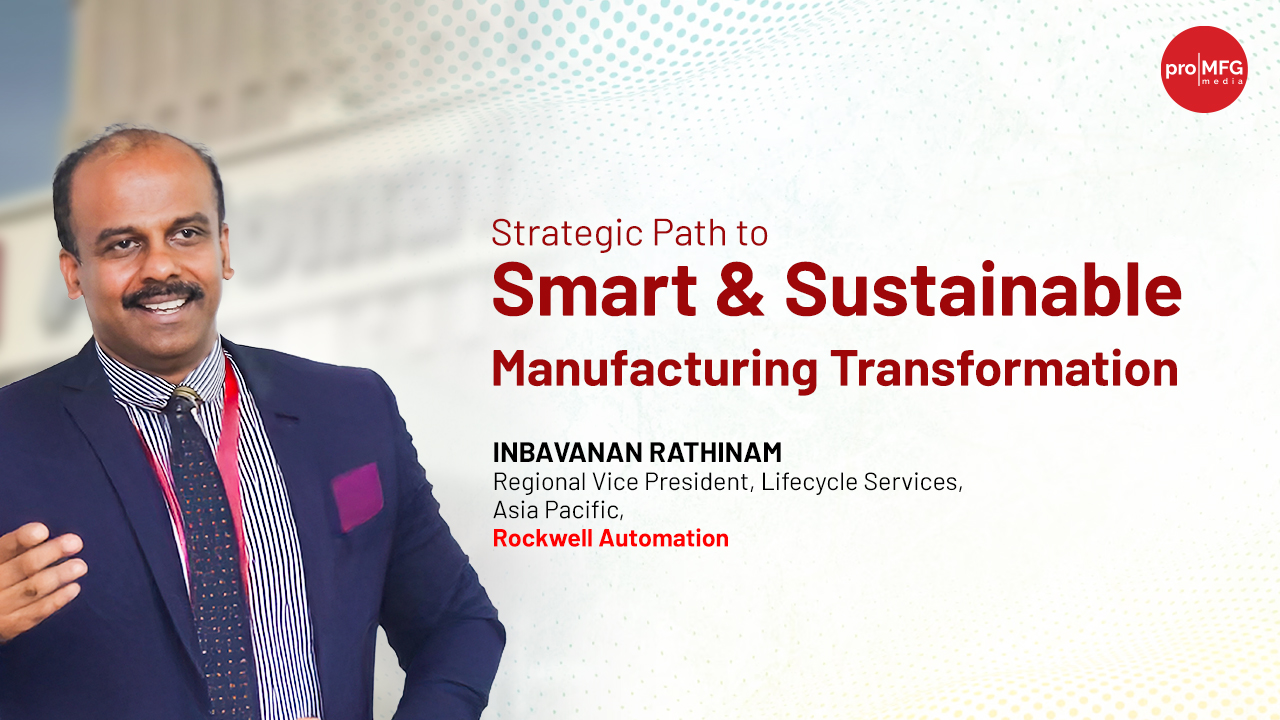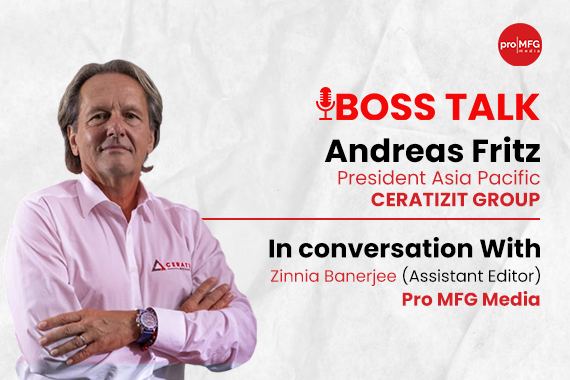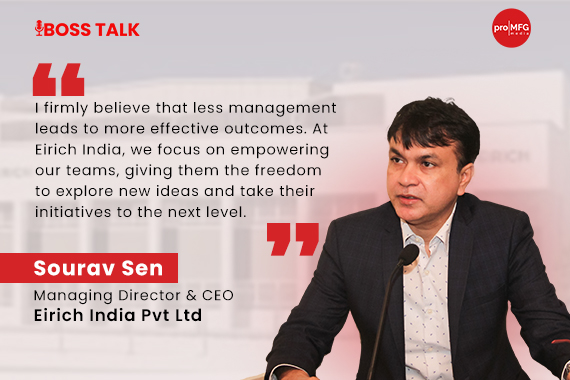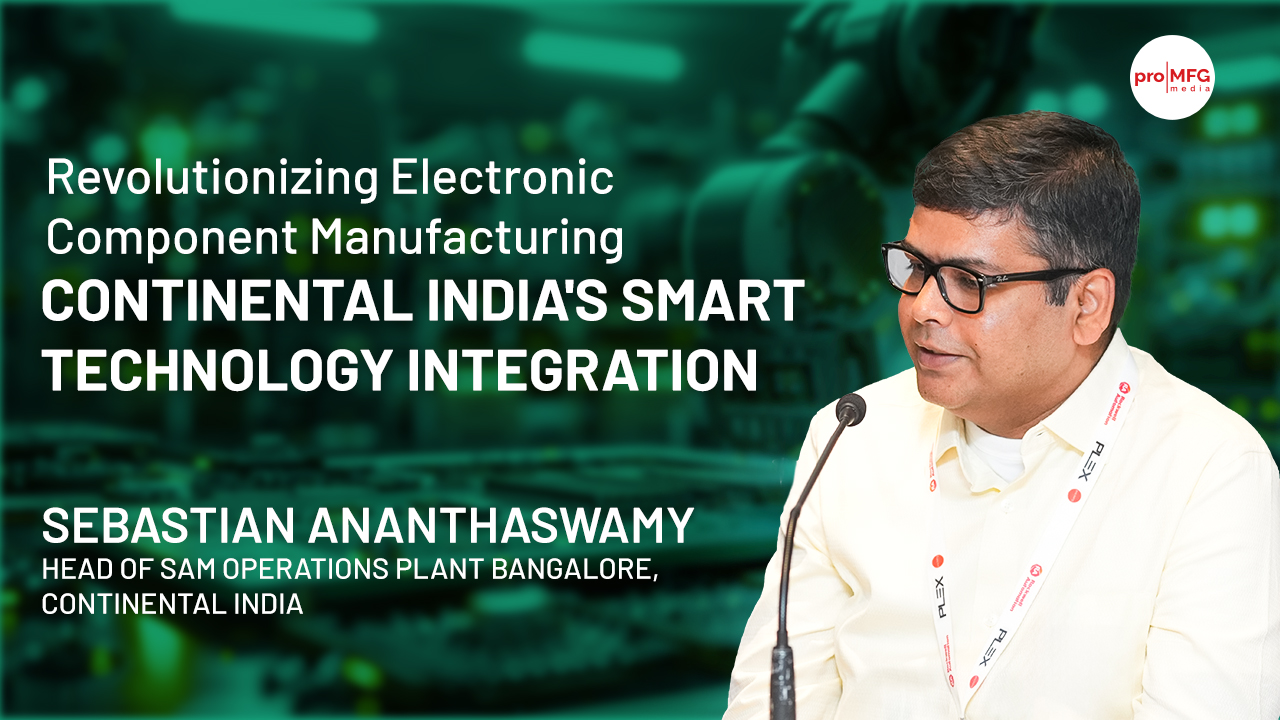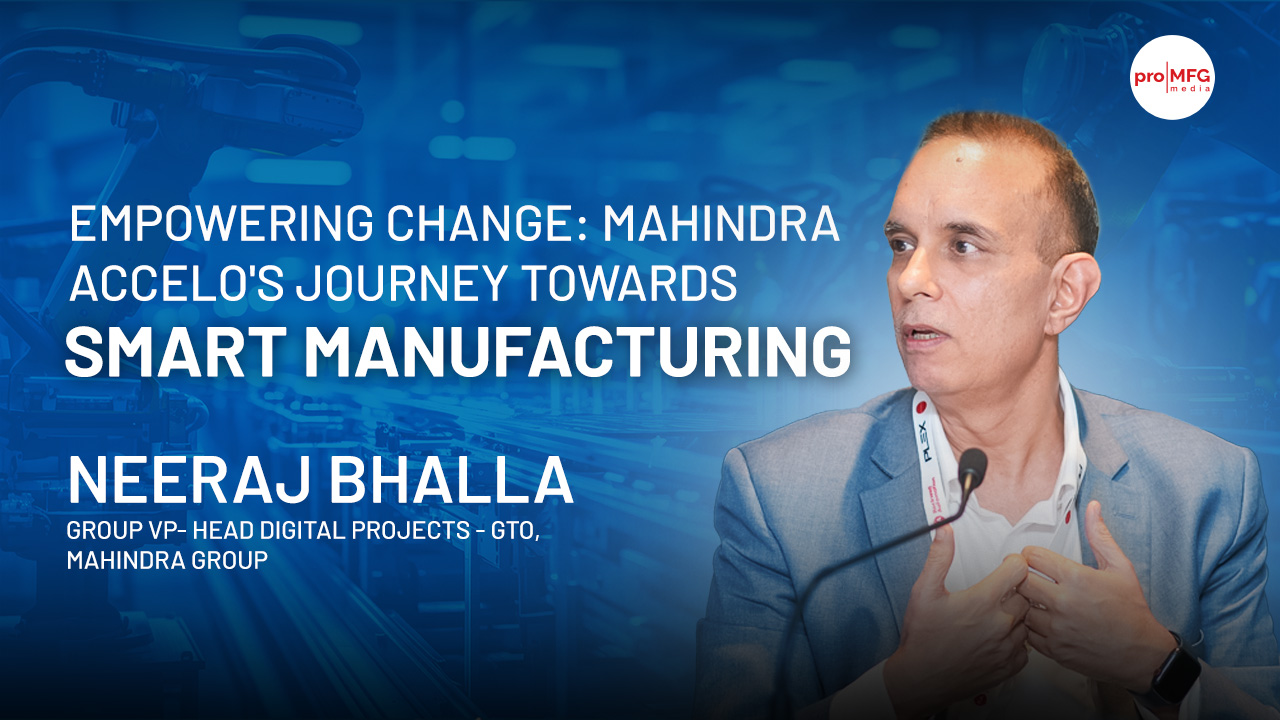“Green is mentioned in terms of greening of the products and processes. The good part of it is you cannot just do good and green and get isolated. So, the good part of it is the products that are targeting the bottom of the pyramid.”
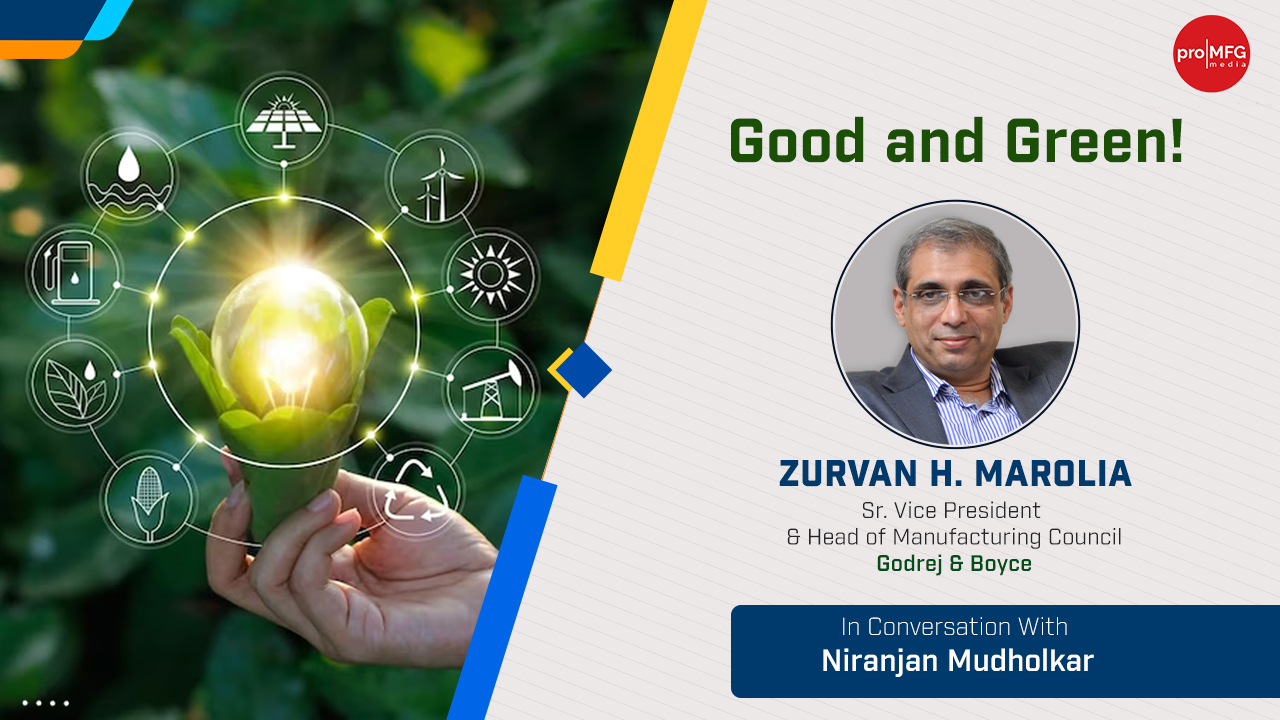
May 2023 : In this free-wheeling and extensive interview with Niranjan Mudholkar, Editorial Director, Pro MFG media, Zurvan H. Marolia, Sr. Vice President & Head of Manufacturing Council, Godrej & Boyce, says that his organization is driven by the ‘good and green’ philosophy that emanates from the strong belief of a triple bottom line – people, planet and shareholders.
What are the top three trends driving the manufacturing business in India today and how is Godrej and Boyce leveraging the same?
In terms of the top three trends, they are all interconnected. One would be the movement on Industry 4.0, second being a shift to smart manufacturing and the third one is the use of advanced analytics for data mining to improve our competitive edge as well as to improve customer experience. After all, a competitive edge will only come from customer experience. It is critical to have all these three trends on a bedrock of sustainability. I call sustainability a bedrock because that is something on which we need to entirely build.
In terms of how Godrej & Boyce is leveraging these trends, I would say that we have used new projects for the last 8-10 years to gradually build the smartness quotient of our manufacturing facilities. So, from a plain simple IoT whereby machines could be programmed from a central point on the shop floor to then gradually building in the use of AGVs to then to be gathering data back from the machine, we are using it all. The initial part is more of connectivity, and then it is more in terms of getting feedback from the machines. This has led to leveraging that information, then improving the process capability indices, and thereby improving the quality.
Getting things right the first time becomes very critical from a competitiveness point of view. And then again to use this data to improve predictability of the processes is very critical from a customer point of view. The customer, at the end of the day, is willing to wait only up to a point. So, bringing predictability and trackability into the system is critical. Also, with this kind of analytics, we can then improve on the sustainability factor in terms of enhancing the productivity per unit of energy consumed to reduce the water consumption. Godrej & Boyce has been moving on this across all our businesses because we have been looking at some expansion either in terms of the same premises or in certain cases, completely new Greenfield projects. So, all the new investments that are made are done keeping this in mind. That is how we are taking it forward for Godrej & Boyce on these various trends in the manufacturing sector.
Indeed, sustainability is the bedrock of these trends. When we talk about manufacturing, it’s all driven by operations. Whether you speak about quality, productivity and even innovation for that matter, you have to ensure that you get your operations right as well as efficiently, and then ultimately strive for operational excellence. You mentioned industry 4.0 as one of the trends in the industry today. Do you see digitalization helping manufacturing companies achieve operational excellence?
Absolutely. Digitalization is something that we started in Godrej & Boyce way before Industry 4.0 was heard of as a trend. To answer the question on how important digitalization is: What gets monitored gets performed! That is something that we all know, and digitalization really helps in bringing a large number of measurable parameters onto a platform where they can be monitored, where you can do huge amounts of data crunching in order to be able to understand what is being done and how you are really performing. There are basic pillars on which any manufacturing operation stands i.e., quality, delivery and cost. And that really is what drives the competitiveness and therefore the success of any manufacturing industry. Now, if you take each of these, digitalization is one of the larger contributors to it. Let’s look at quality from the process capability perspective. How stable is my process? Is it able to deliver what I want? Can it give me the required consistency? Digitalization gives me this data. More importantly, in fact, the next step is to use that data also for monitoring the performance of the machines. At what point do the machines require maintenance? Do they require some kind of attention? Do they need some kind of adjustments, settings or tunings? The idea is that it helps us to get quality right spot on and for the first time. Any rework or refinement is a non-value-added cost. At the end of the day, the customer is at the center of this whole thing. The entire thing is driven by the customer.
Let me now talk about delivery. When we were discussing the earlier question about predictability and traceability, I mentioned that a customer is willing to wait but to a committed date. After that, if there is a delay, there is impatience, and rightly so. So, we need to bring predictability, and that also requires tractability. So, at any point of time, you set milestones in the system to know whether the product is moving on time. Of course, I am not referring to the off-the-shelf products here. I am referring to engineered solutions for the customer. You can call it customization.
And the third one is cost, which is very all-encompassing. It’s got a quality, delivery and sustainability factor into it. Why sustainability? Because when you monitor through digitization, you are able to cut waste from the system. For example, even in product testing, when you use digitization, which is one of the first things that we did 10 years ago by identifying the point at which a product is failing, one can identify which is the optimum spot at which material needs to be added or strengthened, which are the areas where you have probably over designed. This helps you to bring about a more optimum utilization of material. Also, material yields can be sort of monitored very effectively using this. So, in digitalization: a) what gets monitored gets performed b) It allows you to deal with large tracts of data, data mines as you could call them and use that to analyze and enhance the performance on the three parameters of quality, delivery and cost.
For delivery, you can also add optimal logistics where again digitalization plays a role. So, at the end of the day, it all comes down to customer experience.
The key takeaway for me from your answer is that digitalization gives you the power to monitor, measure, analyze and, of course, then control. So, I think that is where digitalization stands apart as a differentiator. Just adding on to that question, do you also see digitalization as a key tool for innovation? And when I say innovation, I don't just mean products, I also mean the processes. And in fact, the way an organization functions.
I would say that everybody is intrinsically innovative because a lot of ideas spring to mind. But then at some point inertia takes over it. Can I take this risk? Can I do this? Can I touch a running system? And what will happen? Will the whole thing deliver as per what I have in mind or is it something that’s going to collapse? So, digitization and digitalization allow us to do a very quick what-if analysis and the creation of digital twins to do basic testing on digital models and help us basically cut down the development time. So, testing and analytics become much more effective. Using digitalization and testing also helps us in optimization. These are all under the broad umbrella of innovation. So yes, what it does is that it removes the barriers of innovation. You could say the mental barriers are not there, but at the end of the day, there is inertia that plays a role. And digitalization does help cutting down those and making it easy to quickly try out innovative ideas as well as to cut down the time taken in the process.
Absolutely. I completely agree with you on both points - humans intrinsically are innovative by nature, but then at some point in time, inertia always creeps in. People who do well are the ones who overcome that inertia. The same applies for organizations as well. So, my next question is about people here. Organizations are adopting and implementing technologies to stay competitive, which means that people need to unlearn a lot of old ways of working and they have to learn a lot of new ways of working. So, how do you see the picture of human resources evolving in this scenario of digitalization?
It is no more a choice! It has to be done. It has to happen and it will happen. Today, it’s all about being competitive and competitiveness driven in terms of bringing transformation in human skill. And you’re right, it will require some amount of unlearning or deskilling. And then, reskilling, and upskilling. Various initiatives that we have put into place are closing the growing skill gap. So, in fact, today's academics itself do not adequately prepare new entrance into the industry and that is where industry has to get into the training mode very quickly. For example, we have our own Diginxt initiative where we are building the necessary skills in the operating teams. The pandemic forced us to take certain steps forward in investing in time and effort. Today, talking on MS Teams is something which has become common. We had heard of MS Teams previously, but grasped it during Covid and now we can’t function without it.
Apart from that, bringing in AR and VR for training is something that we have been doing. For example, earlier if any new machine was invested in, people would physically go to the manufacturer to get trained and get involved in the actual job. But this is all done then with the help of AR & VR now. Similarly, the help that the manufacturer of the equipment can give us rather than sending somebody here in case of a crisis, are things which Covid brought upon us.
In the context of our supply chain channel partners, we have actually had this whole movement called Beyond Sourcing, which is now in its 16th year. We have gradually trained our partners and tuned them, thereby closing the skill gap on various aspects. This is not just in terms of digitalization, but also in terms of certain degrees of management skills because there are small supplier partners who would typically be family run businesses and who had to be brought into the formal and structured management planning. Also, we have taken them to levels of business excellence and green manufacturing. So, this entire movement together is developing this mass of workforce. And we all have to do it because we are moving towards it; there is no other option left!
I think that’s a very valid point that you mentioned that we all have to do it. It's not just about one organization or another. And I think it is commendable what your organization is doing in terms of getting the entire value chain or rather the ecosystem involved in terms of training, not just on the terms of digitalization, but holistically. It does have a ripple effect across the industry and everybody kind of comes on the same platform. You mentioned sustainability being the bedrock of everything that we do nowadays. Could you share a few initiatives that your organization in particular is doing on that front?
So, we have this umbrella initiative called ‘Good and Green’. Green is mentioned in terms of greening of the products and processes. The good part of it is you cannot just do good and green and get isolated. We just talked about the human resource factor developing the good part of it. So, the good part of it is the products that are targeting the bottom of the pyramid. Then, we are also developing skills in the workforce for employability. So, this is a whole initiative that is driven by Mr. Jamshyd N Godrej, our Chairman, and, of course, our CEO Mr. Anil Verma.
This good and green philosophy emanates from the strong belief of a triple bottom line – people, planet and shareholders. Just to give you a couple of numbers which I have over here with me. 1) We make products from waste materials like recycled concrete blocks. So, we bring all the rubble that is generated from various construction sites and actually make concrete blocks which then go back into the construction industry – this involves recycling of more than 25,000 metric tonnes of concrete waste. 2) We are saving 4.15 million kilolitres of water. 3) We are employing or creating employment for 169,000 youths.
In terms of good and green products, we are at about 31 percent of the company’s revenues. That is ₹3762.1 crore. Energy productivity has nearly doubled in the last 10 years; so, it’s increased 96 percent. We have 275 plus products which are green certified now. This is becoming more and more important. Again, as I said, it’s customer centric. The customers are making conscious green buying decisions.
And there’s the health factor as well, because part of the green in this initiative is the use of low VOC (volatile organic compounds) chemicals. In earlier decades, you could walk into a freshly done up office and your eyes would start watering. It could be the paint or it could be some chemicals used for some adhesives. Those things are of the past today. You hear about water-based paints, glues and chemicals. So that’s all part of the greening that has gone into it. Our renewable energy share has also gone up substantially. It’s still a long way to go in it, but we are at the 12 percent mark. We have offset 48 percent of our carbon footprint in the last 10 years. All our plants are water positive and we have successfully collected and disposed of 39,900 tonnes of e-waste. So, that gives you an idea as far as what G&B is doing.
Similarly, we have worked with our supply chain partners on the reduction in scrap generation and disposal reduction in energy consumption, use of renewable energy. Also, we evaluate our suppliers on these various criteria: quality management, logistics management, manufacturing, environmental parameters and so on.
Recently, I was addressing a couple of our supplier meetings. We talked about the fact that today it requires us to cut costs not by cutting margins but by cutting waste. One of the major ways to achieve this is getting things right the first time. We have to recognize the fact that the customers will pay for the products they get. They will not pay for any inefficiencies in the system because whoever can be more efficient will be able to give a product to the customer at a lower cost and still be profitable. And it is important that we take ourselves there because to be recognized as a global manufacturing player, we need to get this act right and first times in places. So far, we have got 15 of our suppliers who have been Green Co certified and I would expect that number to more than double within the next year because there are that many in the pipeline as well.
NEWSLETTER
TRENDING ON PRO MFG
MORE FROM THE SECTION




.jpg)
